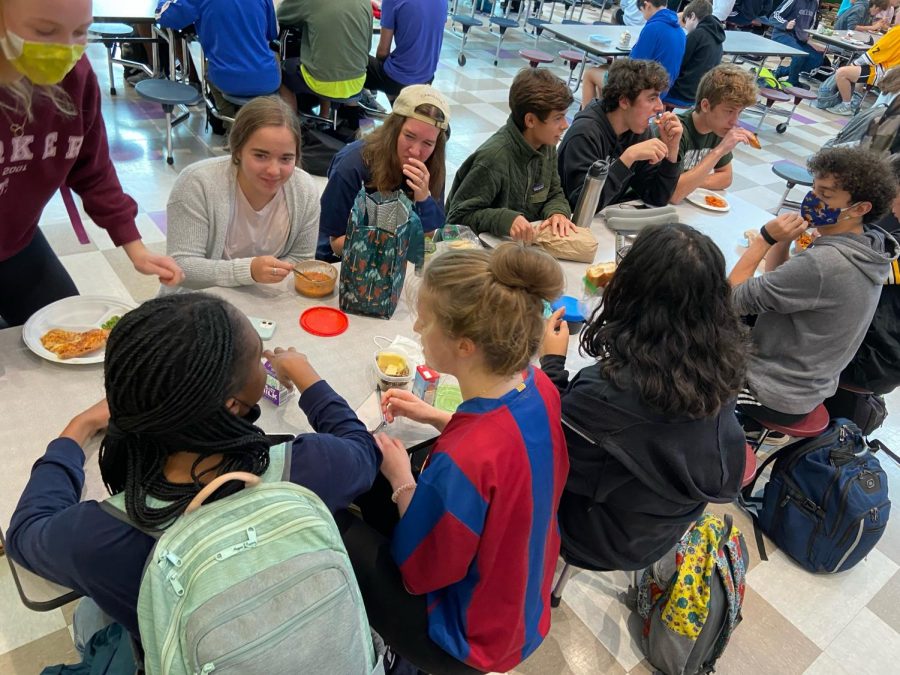Pioneer and AAPS must improve COVID safety protocols
Aug. 27 saw the return of students to Pioneer, many after an 18-month hiatus. And while the district has stated that its number one goal is the health and safety of the community, their COVID mitigation efforts have fallen short.
According to the Ann Arbor Public Schools’ Health and Safety protocols for the 2021-22 school year, the primary objective of the district is “to keep school buildings open to in-person learning with safe and healthy environments for students, faculty and staff.”
However, seating arrangements at school, as well as a lack of communication from school officials, puts the reality of student’s safety into question.
Throughout the COVID-19 pandemic, the guidance from health professionals has been to maintain at least three feet of social distance while wearing masks and six feet when not. Despite this, the Pioneer cafeteria is largely functioning as it would any other year. The school has set up tables outside, and is looking to expand their reach to allow for more social distancing space between students. However, inside the cafeteria, students crowd around tables with seats just seven inches apart, nowhere near the six feet recommended by the U.S. Centers for Disease Control. With fall and winter bringing colder weather in the next few months, the number of students eating inside will only grow. While it would still be well short of six feet, removing or crossing off every other cafeteria seat would provide a safer eating space for students, and reduce the COVID risk to the community.
Additionally, lunches and outside events make contact tracing an imprecise art. In the classroom, seating charts are used to identify close contacts by keeping track of individuals who sit within three feet of each other with masks for more than 15 minutes. However, at lunch, this is done through word of mouth. Students must remember and identify those who sat within six feet of them (unmasked) for 15 or more minutes.
In the spring, this caused some hiccups. Pioneer Principal Tracey Lowder said some students were hesitant to reveal who they’d been near, trying to protect their friends from having to quarantine. But a possible method to alleviate certain situations would be to implement sign-in sheets at each table for students to record where they sit. This system is already being used by the media center, limiting possible omissions and helping the contact tracing effort.
Despite required masking, there have been scattered COVID cases across the district, including Pioneer. Unfortunately, communication has been unreliable and untimely. The district as a whole updates their case log just once per week, so cases reported on Thursday nights don’t get logged until the following Friday, eight days later. For example, a case that was reported through a notification letter from Pioneer Principal Lowder went out on Sept. 17. The case, reported just after the dashboard’s update, will not show up until Sept. 24. This timeline has led to confusion about the reality of COVID cases at school, and could be helped simply by updating the dashboard more often.
Pioneer’s communication had been worse. Since the beginning of the school year, AAPS’s four largest schools––Pioneer, Huron, Skyline, and Community––have each reported several COVID cases. Skyline, Huron and Community have done their due diligence of following up every reported case with a notification letter to their respective schools and posting the letters on their websites. Pioneer, until recently, has not. Despite multiple cases being reported during the first two weeks of school––the weeks of Aug. 27 and Sept. 3––the first letter from Principal Lowder advising of the situation was not sent out until Sept. 10. Since then, the school has improved: each reported case has been accompanied by a notification letter, with the letters being posted on the school website as well. This is a welcomed development, helping students and families understand the school’s latest COVID situation, but why so late with this urgent communication? We can do better.
Pioneer has been making progress in its adaptation to COVID, but there remain a number of ways in which the school and the district could improve. To ensure COVID safety, the school should increase social-distancing in the cafeteria and provide a sign-in sheet at each table, as well as release more frequent updates of the case dashboard. While it is true that COVID cannot be avoided altogether, effective safety and security protocols are essential to prevent and handle possible outbreaks. Pioneer should lead the way, not try to catch up from behind.


